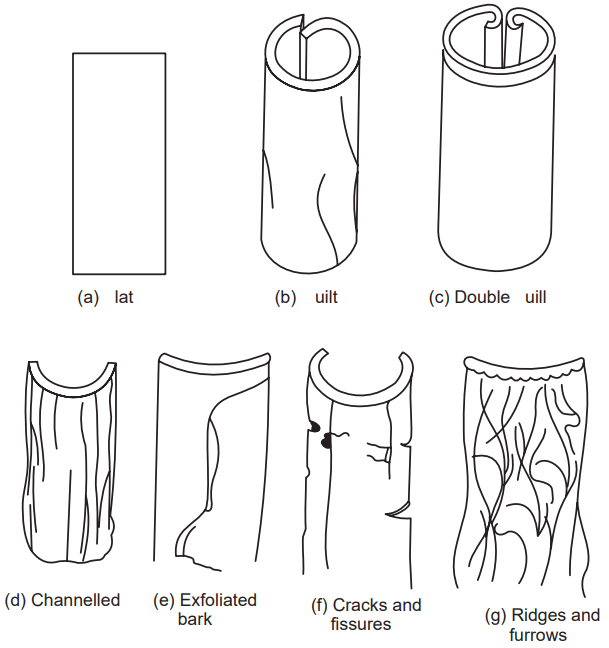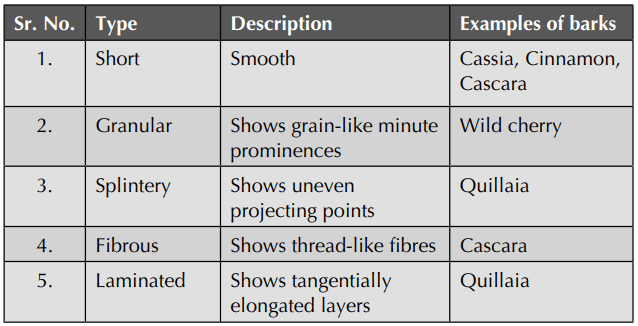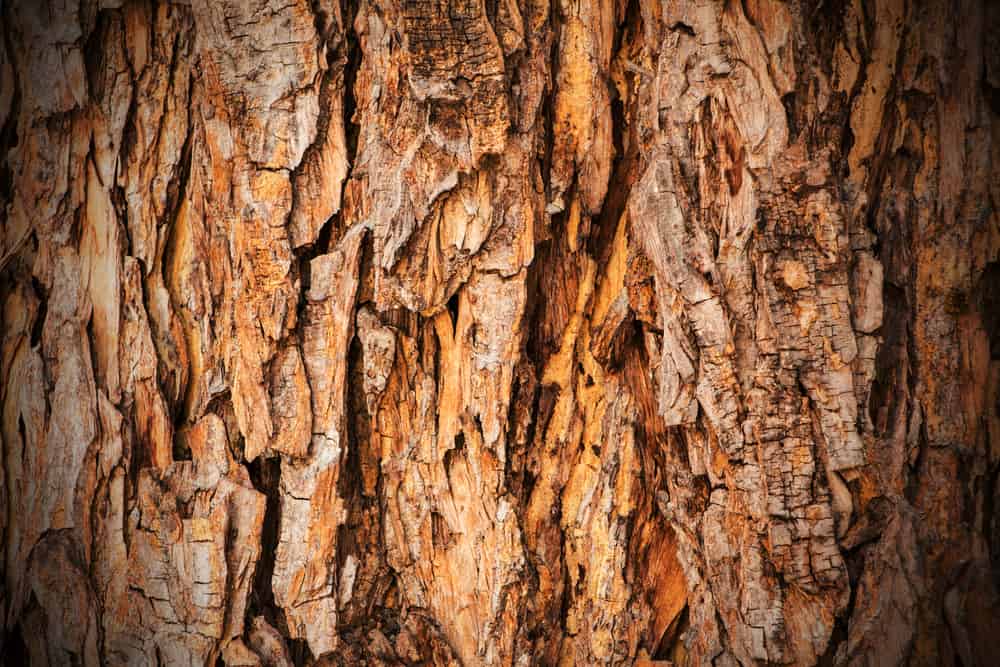Morphology of Bark: The bark (in commerce) consists of external tissues lying outside the cambium, in the stem or root of dicotyledonous plants. Following are the tissues present in the bark:
Cork (phellum), phellogen and phelloderm (collectively known as periderm), cortex, pericycle, primary phloem, and secondary phloem.
In Botany, the bark consists of periderm and tissues lying outside it, i.e. cork, phellogen, and phelloderm.
Methods of collection of barks
The bark is generally collected in spring or early summer because the cambium is very active and thin-walled and gets detached easily. Following are the methods of collection of barks.
1. Felling method: The fully grown tree is cut down near the ground level by an axe. The bark is removed by making suitable longitudinal and transverse cuts on the stem and branches. The disadvantages of this method are (a) the plant is fully destroyed and (b) the root bark is not utilized.
2. Uprooting method: In this method, the stem of definite age and diameter are cut down, the root is dug up and bark is collected from roots, stems, and branches. In Java, cinchona bark is collected by this method.
3. Coppicing method: The plant is allowed to grow up to certain age and diameter. The stems are cut at a certain distance from ground level. The bark is collected from stems and branches. The stumps remaining in the ground are allowed to grow up to a certain level; again the shoots are cut to collect the bark in the same manner. Cascara bark and Ceylon cinnamon bark are collected by this method.
Morphology of bark
The following features may be used to describe the morphology of the bark.
1. Shape:
The shape of the bark depends upon the mode of cuts made and the extent and shrinkage that occurred during drying.
- Flat: When the large piece of the bark is collected from the old trunk and dried under pressure, the bark is flat, e.g. Quillaia and Aarjuna barks.
- Curved: Here, both the sides of the bark are curved inside, e.g. Wild cherry, Cassia, and Cascara barks.
- Recurved: Both sides of bark are curved outside, e.g. Kurchi bark.
- Channelled: When the sides of bark are curved towards the inner side to form a channel, e.g. Cascara, Cassia, and Cinnamon barks.
- Quill: If one edge of bark covers the other edge, it is called quill, e.g. Ceylon, Cinnamon, and Cascara barks.
- Double quill: Here, both the edges curve inward to form a double quill, e.g. Cinnamon and Cassia barks.
- Compound quill: When the quills of smaller diameter are packed into bigger quills, it is called compound quills. Compound quills are formed to save space in packing and transportation, e.g. Cinnamon bark.

2. Outer surface:
- Smooth: When the development of cork is even, e.g. Arjuna bark.
- Lenticels: They are transversely elongated holes formed on the outer surface because of lateral pressure, e.g. Wild Cherry and Cascara barks.
- Cracks and fissures: They are formed due to an increase in diameter, e.g. Cinchona bark
- Longitudinal wrinkles: They are formed because of shrinkage of soft tissues, e.g. Cascara bark.
- Furrows: If troughs between wrinkles are wide, it is called furrows, e.g. Cinchona calisaya bark.
- Exfoliation: Sometimes the cork of bark flakes off exposing cortex, e.g. in Wild cherry bark.
- Rhytidoma: It is composite dead tissue consisting of alternate layers of cork, cortex, and/or phloem, e.g. Quillaia and Tomentosa barks. Sometimes it is removed during peeling.
- Corky warts: They are the small circular patches, found sometimes in old barks, e.g. in Cinchona succirubra and Ashoka barks.
- Epiphytes: Such as moss, lichen, and liverwarts are sometimes seen in bark, e.g. Cascara bark.
3. Inner surface:
The color and condition of the inner surface are of diagnostic value.
- Striations: When parallel longitudinal ridges are formed during drying, it is called striations; they may be fine or coarse, e.g. Cascara bark.
- Corrugations: They are the parallel transverse wrinkles formed due to longitudinal shrinkage, e.g. Cascara bark.
4. Fracture:
The appearance of an exposed surface of transversely broken bark is called a fracture. Different types of fracture, their descriptions, and examples are given in Table.1.
Table.1: Various types of fracture of bark

Histology of barks
The bark shows the following microscopical character:
- Tabular, radially arranged cork cells, maybe suberised or lignified (e.g. in Cassia bark),
- Thin-walled cellulosic parenchymatous phellogen and phelloderm,
- Collenchymatous and/or parenchymatous cortex,
- Parenchymatous or scleranchymatous pericycle; may contain a band of stone cells and fibers,
- Primary phloem which is generally crushed, e.g. in Cascara and Arjuna and
- Secondary phloem consists of sieve tubes, companion cells, phloem parenchyma, phloem fibers, and stone cells. Phloem fibers are thick-walled, lignified, e.g. in Cinchona and Cascara; stone cells are thick, lignified with narrow lumen, e.g. Kurchi and Cinnamon barks; sometimes branched stone cells are seen in Wild cherry bark,
- Thin-walled, living radially elongated medullary ray cells which are uni-, bi- or multiseriate and straight or wavy,
- Starch, calcium oxalate, oil cells, mucilage, etc., are often present in the cortex.
Make sure you also check our other amazing Article on : Cell Contents in Pharmacognosy
